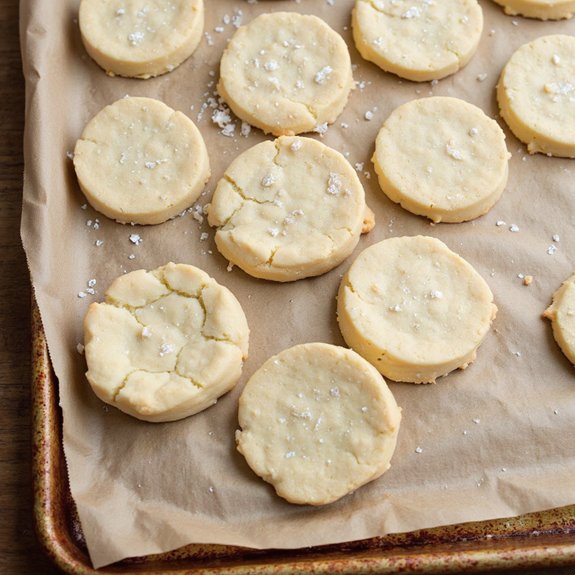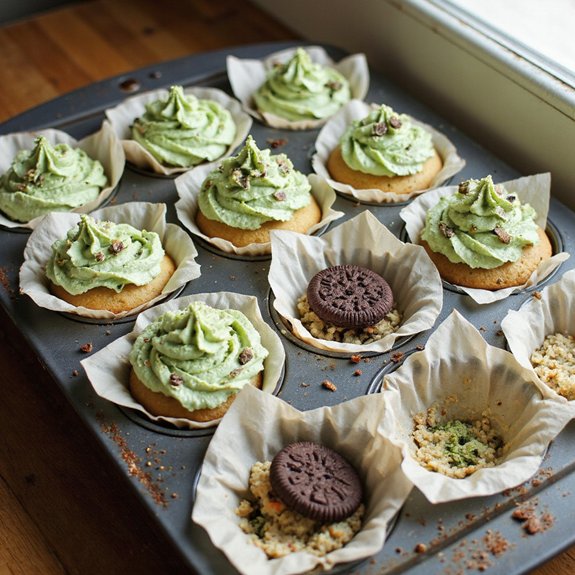Picture a tray of pale-gold rounds emerging from the oven, their edges just blushing, the air sweet with butter and vanilla. Imagine the first bite: a delicate snap yielding to a sandy, melt-in-the-mouth crumb that feels like a warm hug on a chilly afternoon.
Shortbread is comfort dressed in simplicity, and that’s why it matters to me—it turns pantry staples into something quietly elegant, the kind of cookie that makes tea time feel special and weeknights feel less hurried.
These New York–style shortbread cookies have saved me more than once; when guests arrived early one winter evening, I whipped up a batch from chilled dough and had a plate ready before the kettle boiled.
They’re perfect for busy schedules, Sunday suppers, lunchbox treats, or a last-minute dessert that looks thoughtful without fuss. If you’re craving calm, crisp edges, and buttery bliss, you’re in the right place. Ready? Let’s cook!
Why You’ll Love It
- Delivers bakery-style crisp-tender bite with melt-in-mouth crumb
- Uses pantry staples and simple, reliable technique
- Chills quickly, rolls cleanly, and cuts neat shapes
- Bakes evenly with golden edges and delicate vanilla aroma
- Freezes beautifully and refreshes to perfect crunch in minutes
Ingredients
- 226 g unsalted butter softened — room-temp for best creaming
- 100 g granulated sugar — superfine dissolves more evenly
- 50 g confectioners’ sugar sifted — prevents lumps
- 1 tsp vanilla extract — pure, not imitation
- 1/2 tsp kosher salt — Diamond Crystal preferred
- 300 g all-purpose flour — weigh for accuracy
- 30 g cornstarch — tender crumb helper
- 30 g rice flour optional — adds extra snap
- 1 large egg white optional — for glossy brush
- 25 g coarse sugar optional — crunchy topping finish
Step-by-Step Method
Cream the Butter & Sugars
Beat softened butter with granulated and confectioners’ sugars on medium speed until light and fluffy, about 2 minutes. Scrape the bowl once to guarantee even aeration. Aim for a pale, creamy mixture—it sets the cookie’s tender crumb. Avoid overbeating, which can incorporate too much air and cause spreading.
Blend in Vanilla & Salt
Add vanilla extract and kosher salt. Mix briefly until fully incorporated. This evenly disperses flavor without overworking the butter. Scrape down the sides and bottom of the bowl to guarantee no unmixed patches remain. Keep the mixture smooth and cohesive.
Whisk the Dry Ingredients
In a separate bowl, whisk all-purpose flour, cornstarch, and rice flour if using. Break up any lumps for an even blend. This prevents streaks and promotes a consistent, delicate texture. Keep the mixture airy to help the dough come together quickly and cleanly.
Combine to Form Dough
Add dry ingredients to the butter mixture. Mix on low just until a soft dough forms and no dry streaks remain. Stop as soon as the dough clumps together. Overmixing can toughen shortbread. Gather the dough with a spatula to finish bringing it together gently.
Chill into Disks
Divide the dough in half. Press each portion into a flat disk for faster chilling. Wrap tightly in plastic and refrigerate for 30 minutes, until firm yet pliable. Proper chilling keeps shapes crisp and reduces spreading during baking. If sticky, chill longer.
Preheat & Prepare Pans
Heat the oven to 325°F (165°C). Line two sheet pans with parchment to prevent sticking and promote even browning. Set up a lightly floured work surface. Have a 2-inch cutter, rolling pin, and extra flour ready. Work efficiently to keep dough cool.
Roll to Even Thickness
Roll one dough disk to 1/4 inch thickness on a lightly floured surface. Rotate the dough and dust lightly as needed to prevent sticking. Keep thickness consistent for even baking. Alternatively, pat by hand for a rustic look. Leave the second disk chilled.
Cut & Reroll Neatly
Cut rounds with a 2-inch cutter, pressing straight down. Gather scraps, gently press together, and reroll once to avoid toughness. Alternatively, slice bars with a sharp knife for clean edges. Aim for uniform sizes to ensure even doneness across the batch.
Arrange, Brush & Sprinkle
Place cut cookies on prepared pans, spaced 1 inch apart. If using, lightly brush tops with egg white for shine and adhesion. Sprinkle with coarse sugar for sparkle and crunch. Work quickly to keep dough cool. Chill the tray briefly if the dough softens.
Bake Until Just Golden
Bake one sheet at a time for 18–25 minutes. Look for pale golden edges and set centers. Rotate the pan once for even color. Avoid deep browning to keep a tender crumb. Adjust time based on thickness and your pan’s color—dark pans bake faster.
Cool & Set the Texture
Let cookies cool on the pan for 5 minutes to set their structure. Transfer carefully to a wire rack to cool completely. This prevents steam from softening the bottoms. Once cool, store in an airtight tin. Refresh briefly at 300°F if needed for crispness.
Ingredient Swaps
- No rice flour? Use 10 g more cornstarch (total 40 g) for extra tenderness, or swap in fine semolina for a slightly sandier bite.
- Dairy-free: Replace butter with a high-fat plant butter (stick style, 80%+ fat); avoid tub margarines.
- No confectioners’ sugar: Pulse granulated sugar with 1 tsp cornstarch per 50 g in a blender until powdery.
- Gluten-free: Substitute a 1:1 gluten-free flour blend; keep the cornstarch and consider 1–2 tsp milk or water if dough seems dry.
- Flavor swaps: Use almond or lemon extract instead of vanilla; add citrus zest or a pinch of cinnamon.
You Must Know
- Doneness • If the bottoms look pale but the centers feel soft, leave them in until the edges show a “halo” of color and the tops lose their raw sheen; you’re aiming for pale golden edges and a firm center that springs back lightly, usually around 20–23 minutes at 325°F.
- Troubleshoot • When the dough crumbles or cracks while rolling, knead in 1–2 tsp room‑temp butter per 300 g flour until it just holds; low hydration and cool fat cause dryness—stop once it’s smooth to avoid toughness.
- Avoid • To prevent spread and lose that crisp snap, keep dough temp cool; if it feels tacky or leaves residue on your fingers, chill 10–15 minutes between cuts—warm fat melts early and blurs edges.
- Scale • For half or double batches, keep thickness at 1/4 inch and adjust time by ±2–3 minutes; use 300 g flour base per batch as your benchmark and maintain the butter:total starch (cornstarch + rice flour) ratio to preserve texture.
- Flavor Boost • For a classic bakery aroma, add 1/2 tsp almond extract or 1 tsp finely grated lemon zest per batch; the fat carries these volatiles well—taste the raw dough (no egg yolk present) to gauge intensity before chilling.
Serving Tips
- Serve with hot tea or espresso; add lemon zest for a bright contrast.
- Plate alongside fresh berries and a dollop of lightly sweetened whipped cream.
- Make ice cream sandwiches with vanilla or salted caramel gelato.
- Dip half in dark chocolate; sprinkle sea salt for a bakery finish.
- Crumble over yogurt or custard for a crunchy dessert topper.
Storage & Make-Ahead
Store baked cookies airtight at room temperature up to 7 days.
In the fridge, they keep 10–12 days.
Dough can be made ahead: chill disks up to 3 days or freeze up to 2 months, well-wrapped.
Baked cookies also freeze well for 2 months.
Re-crisp at 300°F for 5 minutes.
Reheating
Refresh shortbread gently: microwave 5–8 seconds wrapped in paper towel.
Oven at 300°F for 5 minutes on a sheet.
Stovetop skillet on low heat 1–2 minutes each side restores crispness.
Tin-Ceiling Bakery Windows
Once those cookies regain their snap, I set them by the window where tin-ceiling reflections ripple across the glass like antique silver. Afternoon light skims the pressed patterns overhead, casting scalloped shadows that look like lace on the panes.
You can hear the city hum outside, but in here the tin glints softly, and the shortbread smells buttery and calm. I love how the ceilings mirror the cookies’ edges—crisp, neat, a little glamorous.
Steam ghosts the glass for a heartbeat when a warm batch joins the cooled ones. I nudge a few into a tin, their sugared tops catching starlight from the ceiling tiles.
Take one, tap it—clean snap—then taste the sandy melt as the room shimmers, bakery and city stitched together.
Final Thoughts
Give these NY Shortbread Cookies a try and see how effortlessly they come together—then make them your own with citrus zest, a cinnamon pinch, or a chocolate dip.
Can’t wait to hear your favorite twist!
Frequently Asked Questions
Can I Make These Gluten-Free Without Gritty Texture?
Yes. I’d swap in a fine 1:1 gluten-free baking blend with xanthan gum, add 10 g cornstarch, and skip rice flour. Chill well, handle gently, and bake just to pale gold—crumbly, buttery, no grit.
How Do Altitude Adjustments Affect Baking Time?
At higher altitudes, I bake longer and slightly hotter: increase temp 10–15°F and expect a few extra minutes. I watch edges turn faintly golden, dough feel drier, aromas deepen, then pull when centers set without shine.
What Mixer Speed Avoids Overworking the Dough?
Use low speed—just above stir. I watch crumbs kiss into a soft, sandy dough, then stop. The bowl smells buttery, the beaters barely whisper. If it smears or warms, I chill and resume gently.
Are There Dairy-Free Butter Substitutes That Still Crisp?
Yes—use refined coconut oil or high-fat vegan block butter; I favor Miyoko’s or Violife. I mix gently, chill well, and bake until edges blush gold. You’ll hear that delicate snap and taste clean, buttery crumble.
How Do I Prevent Cookie Spread in Hot Kitchens?
Chill dough and pans hard, keep butter cool, and preheat fully. I weigh flour, add a touch more starch, and bake one sheet at a time. I feel firm dough; warm smells mean it’s spreading.

NY Shortbread Cookies
Equipment
- 2 Mixing bowl
- 1 stand mixer or hand mixer
- 1 Kitchen scale optional
- 4 measuring cup
- 4 Measuring spoon
- 1 Rubber spatula
- 1 Whisk
- 2 sheet pan
- 2 parchment sheet
- 1 Wire rack
- 1 Rolling Pin optional
- 1 2-inch round cutter optional
- 1 plastic wrap
Ingredients
- 226 g unsalted butter softened
- 100 g granulated sugar
- 50 g confectioners’ sugar sifted
- 1 teaspoon vanilla extract
- 1/2 teaspoon kosher salt
- 300 g all-purpose flour
- 30 g cornstarch
- 30 g rice flour optional, for extra snap
- 1 large egg white optional, for brushing
- 25 g coarse sugar optional, for topping
Instructions
- Cream the softened butter, granulated sugar, and confectioners’ sugar together in a mixing bowl on medium speed until light and fluffy, about 2 minutes.
- Beat in the vanilla extract and salt until combined.
- In a separate bowl whisk together the all-purpose flour, cornstarch, and rice flour if using.
- Add the dry ingredients to the butter mixture and mix on low just until a soft dough forms and no dry streaks remain.
- Divide the dough in half, form into two flat disks, wrap in plastic, and chill for 30 minutes until firm but pliable.
- Preheat the oven to 325°F (165°C) and line two sheet pans with parchment paper.
- On a lightly floured surface roll one disk to 1/4 inch thickness or pat it out evenly by hand.
- Cut rounds with a 2-inch cutter or slice bars with a knife, rerolling scraps gently as needed.
- Arrange cookies on prepared pans 1 inch apart, brush lightly with egg white if using, and sprinkle with coarse sugar.
- Bake one sheet at a time for 18–25 minutes until edges are pale golden and centers are set.
- Cool cookies on the pan for 5 minutes, then transfer to a wire rack to cool completely.





